Lecture Notes in Electrical Engineering 558
Mauro Santos
Jorge Guilherme
Nuno Horta
Logarithmic
Voltage-to-Time
Converter for
Analog-to-Digital
Signal Conversion
�
Lecture Notes in Electrical Engineering
Volume 558
Series Editors
Leopoldo Angrisani, Department of Electrical and Information Technologies Engineering, University of Napoli
Federico II, Napoli, Italy
Marco Arteaga, Departament de Control y Robótica, Universidad Nacional Autónoma de México, Coyoacán,
Mexico
Bijaya Ketan Panigrahi, Electrical Engineering, Indian Institute of Technology Delhi, New Delhi, Delhi, India
Samarjit Chakraborty, Fakultät für Elektrotechnik und Informationstechnik, TU München, München, Germany
Jiming Chen, Zhejiang University, Hangzhou, Zhejiang, China
Shanben Chen, Materials Science & Engineering, Shanghai Jiao Tong University, Shanghai, China
Tan Kay Chen, Department of Electrical and Computer Engineering, National University of Singapore,
Singapore, Singapore
Rüdiger Dillmann, Humanoids and Intelligent Systems Lab, Karlsruhe Institute for Technology, Karlsruhe,
Baden-Württemberg, Germany
Haibin Duan, Beijing University of Aeronautics and Astronautics, Beijing, China
Gianluigi Ferrari, Università di Parma, Parma, Italy
Manuel Ferre, Centre for Automation and Robotics CAR (UPM-CSIC), Universidad Politécnica de Madrid,
Madrid, Madrid, Spain
Sandra Hirche, Department of Electrical Engineering and Information Science, Technische Universität
München, München, Germany
Faryar Jabbari, Department of Mechanical and Aerospace Engineering, University of California, Irvine, CA,
USA
Limin Jia, State Key Laboratory of Rail Traffic Control and Safety, Beijing Jiaotong University, Beijing, China
Janusz Kacprzyk, Systems Research Institute, Polish Academy of Sciences, Warsaw, Poland
Alaa Khamis, German University in Egypt El Tagamoa El Khames, New Cairo City, Egypt
Torsten Kroeger, Stanford University, Stanford, CA, USA
Qilian Liang, Department of Electrical Engineering, University of Texas at Arlington, Arlington, TX, USA
Ferran Martin, Departament d’Enginyeria Electrònica, Universitat Autònoma de Barcelona, Bellaterra,
Barcelona, Spain
Tan Cher Ming, College of Engineering, Nanyang Technological University, Singapore, Singapore
Wolfgang Minker, Institute of Information Technology, University of Ulm, Ulm, Germany
Pradeep Misra, Department of Electrical Engineering, Wright State University, Dayton, OH, USA
Sebastian Möller, Quality and Usability Lab, TU Berlin, Berlin, Germany
Subhas Mukhopadhyay, School of Engineering & Advanced Technology, Massey University, Palmerston
North, Manawatu-Wanganui, New Zealand
Cun-Zheng Ning, Electrical Engineering, Arizona State University, Tempe, AZ, USA
Toyoaki Nishida, Graduate School of Informatics, Kyoto University, Kyoto, Kyoto, Japan
Federica Pascucci, Dipartimento di Ingegneria, Università degli Studi “Roma Tre”, Rome, Italy
Yong Qin, State Key Laboratory of Rail Traffic Control and Safety, Beijing Jiaotong University, Beijing, China
Gan Woon Seng, School of Electrical & Electronic Engineering, Nanyang Technological University,
Singapore, Singapore
Joachim Speidel, Institute of Telecommunications, Universität Stuttgart, Stuttgart, Baden-Württemberg,
Germany
Germano Veiga, Campus da FEUP, INESC Porto, Porto, Portugal
Haitao Wu, Academy of Opto-electronics, Chinese Academy of Sciences, Beijing, China
Junjie James Zhang, Charlotte, NC, USA
�
The book series Lecture Notes in Electrical Engineering (LNEE) publishes the latest developments in
Electrical Engineering - quickly, informally and in high quality. While original research reported in
proceedings and monographs has traditionally formed the core of LNEE, we also encourage authors to
submit books devoted to supporting student education and professional training in the various fields and
applications areas of electrical engineering. The series cover classical and emerging topics concerning:
Communication Engineering, Information Theory and Networks
Electronics Engineering and Microelectronics
Signal, Image and Speech Processing
Wireless and Mobile Communication
Circuits and Systems
Energy Systems, Power Electronics and Electrical Machines
Electro-optical Engineering
Instrumentation Engineering
Avionics Engineering
Control Systems
Internet-of-Things and Cybersecurity
Biomedical Devices, MEMS and NEMS
For general information about this book series, comments or suggestions, please contact leontina.
dicecco@springer.com.
To submit a proposal or request further information, please contact the Publishing Editor in your
country:
China
Jasmine Dou, Associate Editor (jasmine.dou@springer.com)
India
Swati Meherishi, Executive Editor (swati.meherishi@springer.com)
Aninda Bose, Senior Editor (aninda.bose@springer.com)
Japan
Takeyuki Yonezawa, Editorial Director (takeyuki.yonezawa@springer.com)
South Korea
Smith (Ahram) Chae, Editor (smith.chae@springer.com)
Southeast Asia
Ramesh Nath Premnath, Editor (ramesh.premnath@springer.com)
USA, Canada:
Michael Luby, Senior Editor (michael.luby@springer.com)
All other Countries:
Leontina Di Cecco, Senior Editor (leontina.dicecco@springer.com)
Christoph Baumann, Executive Editor (christoph.baumann@springer.com)
** Indexing: The books of this series are submitted to ISI Proceedings, EI-Compendex, SCOPUS,
MetaPress, Web of Science and Springerlink **
More information about this series at http://www.springer.com/series/7818
�
Mauro Santos Jorge Guilherme Nuno Horta
Logarithmic
Voltage-to-Time Converter
for Analog-to-Digital Signal
Conversion
123
�
Mauro Santos
Synopsys Portugal Lda
Porto Salvo, Portugal
Nuno Horta
Instituto de Telecomunicações,
Instituto Superior Técnico
Lisbon, Portugal
Jorge Guilherme
Instituto de Telecomunicações,
Instituto Politecnico Tomar
Lisbon, Portugal
ISSN 1876-1100
Lecture Notes in Electrical Engineering
ISBN 978-3-030-15977-1
https://doi.org/10.1007/978-3-030-15978-8
ISBN 978-3-030-15978-8
(eBook)
ISSN 1876-1119
(electronic)
Library of Congress Control Number: 2019935487
© Springer Nature Switzerland AG 2019
This work is subject to copyright. All rights are reserved by the Publisher, whether the whole or part
of the material is concerned, specifically the rights of translation, reprinting, reuse of illustrations,
recitation, broadcasting, reproduction on microfilms or in any other physical way, and transmission
or information storage and retrieval, electronic adaptation, computer software, or by similar or dissimilar
methodology now known or hereafter developed.
The use of general descriptive names, registered names,
in this
publication does not imply, even in the absence of a specific statement, that such names are exempt from
the relevant protective laws and regulations and therefore free for general use.
The publisher, the authors and the editors are safe to assume that the advice and information in this
book are believed to be true and accurate at the date of publication. Neither the publisher nor the
authors or the editors give a warranty, express or implied, with respect to the material contained herein or
for any errors or omissions that may have been made. The publisher remains neutral with regard to
jurisdictional claims in published maps and institutional affiliations.
trademarks, service marks, etc.
This Springer imprint is published by the registered company Springer Nature Switzerland AG
The registered company address is: Gewerbestrasse 11, 6330 Cham, Switzerland
�
To my parents, Leonel and Ana,
and my wife Yu
To Paula, Inês and Patricia
To Carla, João and Tiago
�
Preface
Data converters are a fundamental building block for many systems and are used for
functions such as digitizing voice, image and wireless telecommunication signals
among others. This is due to the enormous potential of digital signal processing
nowadays, and without data converters, it would not be possible to have devices
such as digital audio and video broadcast, digital cameras and mobile phones.
Usually, the converters employed in those applications have a linear scale, and for
most applications that is the proper choice, however, for some applications, a
nonlinear conversion scale may be more appropriate.
The work presented in this book belongs to the scientific area of analog-to-digital
signal conversion and presents a novel logarithmic conversion architecture based on
cross-coupled inverter. An overview of the current state of the art of logarithmic
converters is given where most conventional logarithmic analog-to-digital converter
architectures are derived or adapted from linear analog-to-digital converter archi-
tectures; this implies the use of analog building blocks such as amplifiers. The use of
such blocks requires additional circuit area and increases the total power con-
sumption. It is also increasingly more difficult to implement these required analog
blocks in more advanced technologies due to the decrease of supply voltages, as
there is less voltage headroom, in short doing the required analog signal processing
in the voltage domain is becoming increasingly difficult. The conversion architecture
proposed in this dissertation differs from the conventional logarithmic architectures.
There is no requirement to use analog blocks such as amplifiers, and part of the
signal processing is done in the time domain. This part of the signal processing is not
affected by the reduction in supply voltages and benefits from the advances in
integrated circuit manufacturing technologies. The signal conversion from the
analog to the time domain is performed by a latched comparator or cross-coupled
inverters. While these circuits are usually seen as digital parts, where only obtaining
a decision within the allocation time matters, here the time required to reach a
decision is the important feature. The study of this voltage-to-time conversion ele-
ment
the required blocks to perform the
analog-to-digital conversion are almost digital blocks, and their speed and precision
should benefit from the advances of integrated circuit manufacturing technologies.
is presented in this document. All
vii
�
viii
Preface
A demonstrator prototype has been designed, simulated, integrated and tested.
To test the demonstrator prototype, a fully custom test platform comprising custom
test software and printed circuit boards has been developed. The demonstrator
prototype achieves a sampling rate of 81.5 MSPS with the full conversion archi-
tecture having an estimated figure of merit of 0.0426 pJ/conversion. The direction of
future research is also identified and includes work such as integration of calibration
in the voltage-to-time conversion element and work on an improved conversion
architecture derived from the architecture proposed in this book.
This work is organized into seven chapters. Chapter 1 presents a brief intro-
duction with the motivation and context to develop and propose new data converter
topology. Chapter 2 discusses the background and the state of the art of nonlinear
A/D converters. Chapter 3 presents and discusses the proposed logarithmic
analog-to-digital converter. Chapter 4 describes the design of the voltage-to-time
converter. In Chap. 5, the circuit designed and the layout are both validated.
Chapter 6 presents and discusses experimental results achieved from an imple-
mented prototype. Finally, in Chap. 7, the conclusions are drawn and possible
future research lines are outlined.
Porto Salvo, Portugal
Lisbon, Portugal
Lisbon, Portugal
Mauro Santos
Nuno Horta
Jorge Guilherme
�
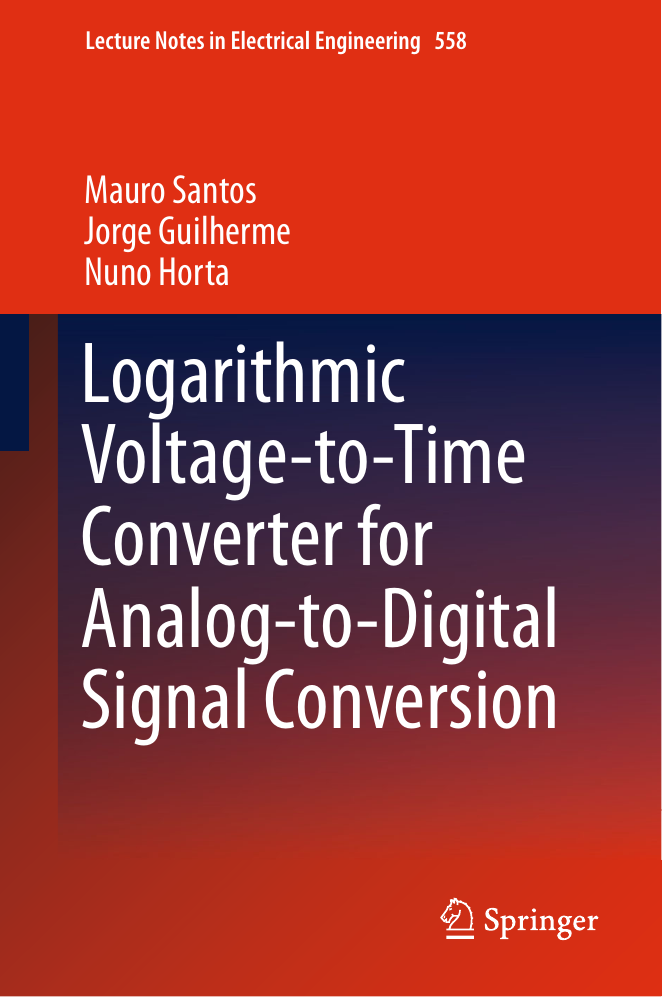
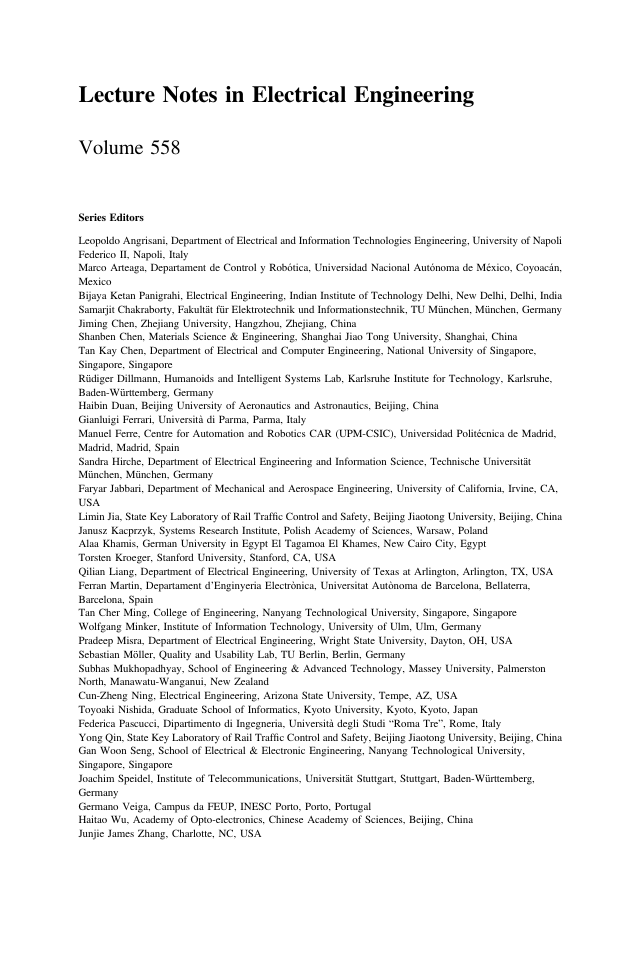


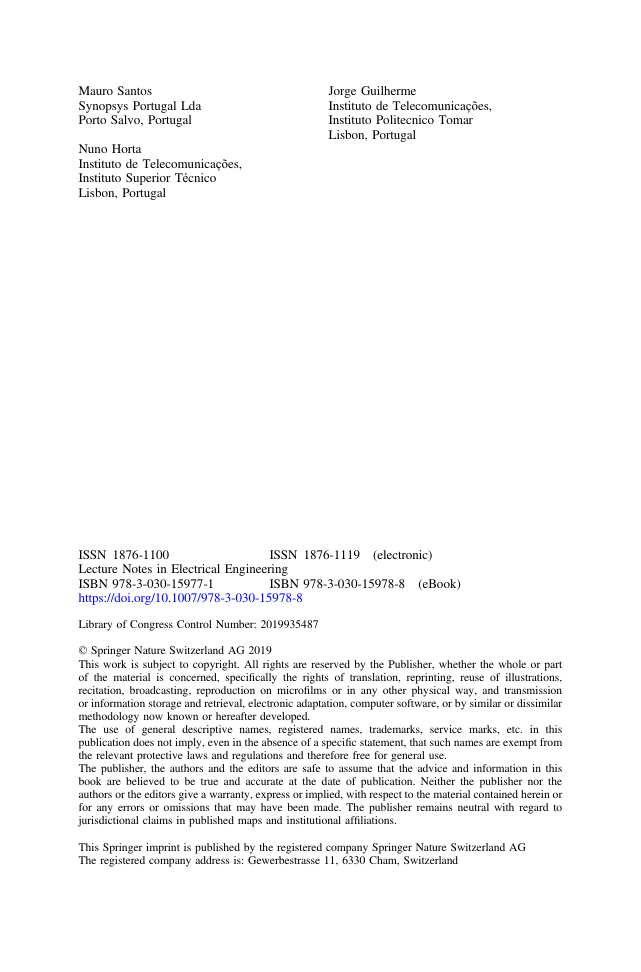

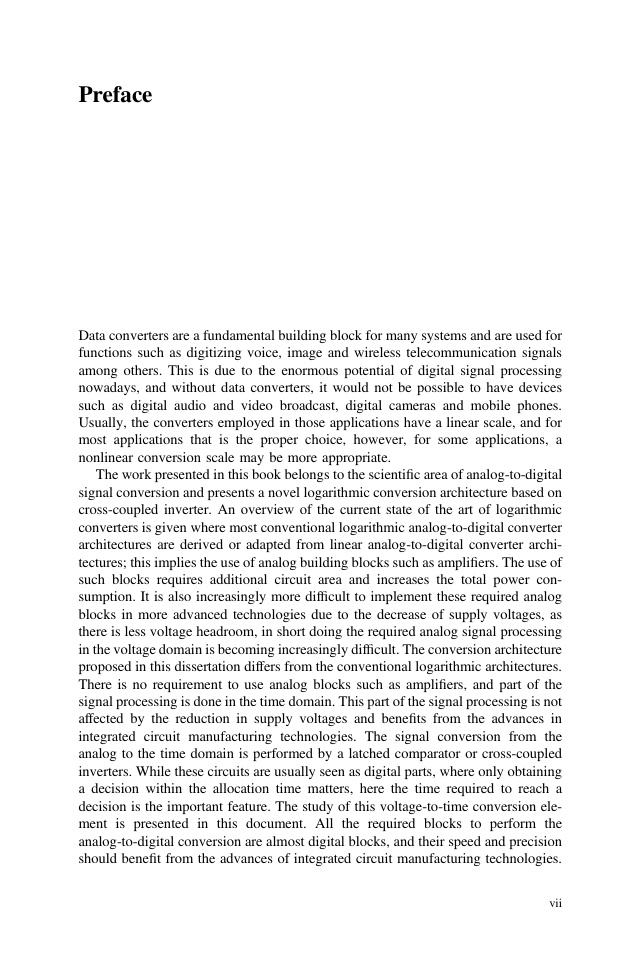
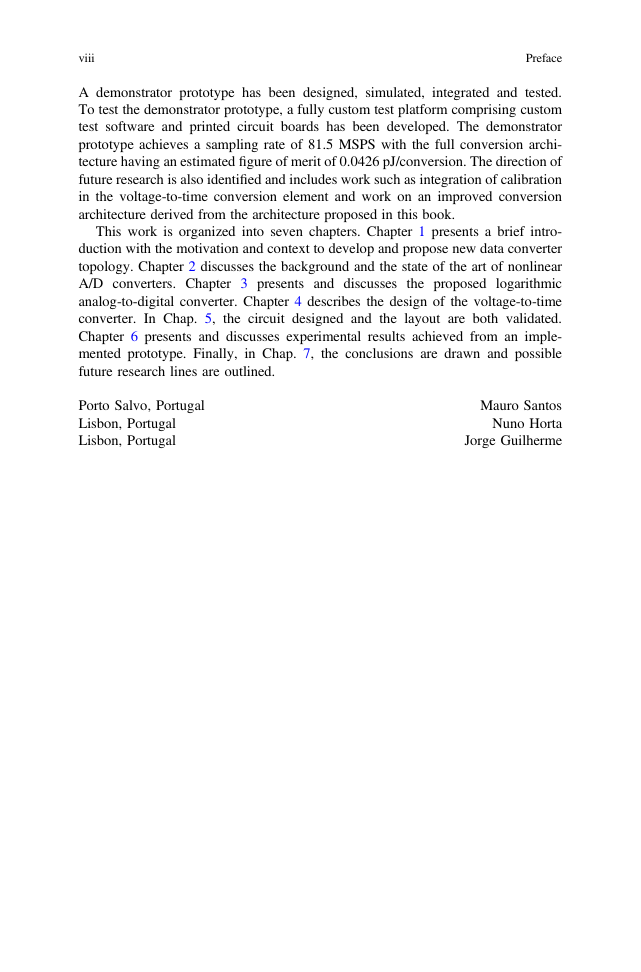








 2023年江西萍乡中考道德与法治真题及答案.doc
2023年江西萍乡中考道德与法治真题及答案.doc 2012年重庆南川中考生物真题及答案.doc
2012年重庆南川中考生物真题及答案.doc 2013年江西师范大学地理学综合及文艺理论基础考研真题.doc
2013年江西师范大学地理学综合及文艺理论基础考研真题.doc 2020年四川甘孜小升初语文真题及答案I卷.doc
2020年四川甘孜小升初语文真题及答案I卷.doc 2020年注册岩土工程师专业基础考试真题及答案.doc
2020年注册岩土工程师专业基础考试真题及答案.doc 2023-2024学年福建省厦门市九年级上学期数学月考试题及答案.doc
2023-2024学年福建省厦门市九年级上学期数学月考试题及答案.doc 2021-2022学年辽宁省沈阳市大东区九年级上学期语文期末试题及答案.doc
2021-2022学年辽宁省沈阳市大东区九年级上学期语文期末试题及答案.doc 2022-2023学年北京东城区初三第一学期物理期末试卷及答案.doc
2022-2023学年北京东城区初三第一学期物理期末试卷及答案.doc 2018上半年江西教师资格初中地理学科知识与教学能力真题及答案.doc
2018上半年江西教师资格初中地理学科知识与教学能力真题及答案.doc 2012年河北国家公务员申论考试真题及答案-省级.doc
2012年河北国家公务员申论考试真题及答案-省级.doc 2020-2021学年江苏省扬州市江都区邵樊片九年级上学期数学第一次质量检测试题及答案.doc
2020-2021学年江苏省扬州市江都区邵樊片九年级上学期数学第一次质量检测试题及答案.doc 2022下半年黑龙江教师资格证中学综合素质真题及答案.doc
2022下半年黑龙江教师资格证中学综合素质真题及答案.doc